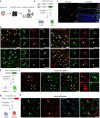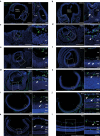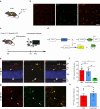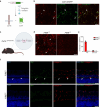Redefining the ontogeny of hyalocytes as yolk sac-derived tissue-resident macrophages of the vitreous body
- PMID: 38961498
- PMCID: PMC11223341
- DOI: 10.1186/s12974-024-03110-x
Redefining the ontogeny of hyalocytes as yolk sac-derived tissue-resident macrophages of the vitreous body
Abstract
Background: The eye is a highly specialized sensory organ which encompasses the retina as a part of the central nervous system, but also non-neural compartments such as the transparent vitreous body ensuring stability of the eye globe and a clear optical axis. Hyalocytes are the tissue-resident macrophages of the vitreous body and are considered to play pivotal roles in health and diseases of the vitreoretinal interface, such as proliferative vitreoretinopathy or diabetic retinopathy. However, in contrast to other ocular macrophages, their embryonic origin as well as the extent to which these myeloid cells might be replenished by circulating monocytes remains elusive.
Results: In this study, we combine transgenic reporter mice, embryonic and adult fate mapping approaches as well as parabiosis experiments with multicolor immunofluorescence labeling and confocal laser-scanning microscopy to comprehensively characterize the murine hyalocyte population throughout development and in adulthood. We found that murine hyalocytes express numerous well-known myeloid cell markers, but concomitantly display a distinct immunophenotype that sets them apart from retinal microglia. Embryonic pulse labeling revealed a yolk sac-derived origin of murine hyalocytes, whose precursors seed the developing eye prenatally. Finally, postnatal labeling and parabiosis established the longevity of hyalocytes which rely on Colony Stimulating Factor 1 Receptor (CSF1R) signaling for their maintenance, independent of blood-derived monocytes.
Conclusion: Our study identifies hyalocytes as long-living progeny of the yolk sac hematopoiesis and highlights their role as integral members of the innate immune system of the eye. As a consequence of their longevity, immunosenescence processes may culminate in hyalocyte dysfunction, thereby contributing to the development of vitreoretinal diseases. Therefore, myeloid cell-targeted therapies that convey their effects through the modification of hyalocyte properties may represent an interesting approach to alleviate the burden imposed by diseases of the vitreoretinal interface.
Keywords: CSF1R; Cx3cr1; Development; Fate mapping; Hyalocytes; Macrophages; Turnover; Vitreous body.
© 2024. The Author(s).
Conflict of interest statement
The authors declare that they have no competing interests.
Figures







Similar articles
-
Hyalocytes-guardians of the vitreoretinal interface.Graefes Arch Clin Exp Ophthalmol. 2024 Sep;262(9):2765-2784. doi: 10.1007/s00417-024-06448-3. Epub 2024 Apr 3. Graefes Arch Clin Exp Ophthalmol. 2024. PMID: 38568222 Free PMC article. Review.
-
Transcriptional Profiling Uncovers Human Hyalocytes as a Unique Innate Immune Cell Population.Front Immunol. 2020 Sep 11;11:567274. doi: 10.3389/fimmu.2020.567274. eCollection 2020. Front Immunol. 2020. PMID: 33042148 Free PMC article.
-
Changes in murine hyalocytes are valuable early indicators of ocular disease.Invest Ophthalmol Vis Sci. 2012 Mar 15;53(3):1445-51. doi: 10.1167/iovs.11-8601. Invest Ophthalmol Vis Sci. 2012. PMID: 22297487
-
Hyalocyte origin, structure, and imaging.Expert Rev Ophthalmol. 2022;17(4):233-248. doi: 10.1080/17469899.2022.2100762. Epub 2022 Sep 6. Expert Rev Ophthalmol. 2022. PMID: 36632192 Free PMC article.
-
[Cell biology of hyalocytes].Nippon Ganka Gakkai Zasshi. 2003 Dec;107(12):866-82; discussion 883. Nippon Ganka Gakkai Zasshi. 2003. PMID: 14733134 Review. Japanese.
Cited by
-
Immunoinflammation and post-translational modifications in the aging process.J Transl Med. 2025 Aug 14;23(1):910. doi: 10.1186/s12967-025-06892-7. J Transl Med. 2025. PMID: 40814109 Free PMC article. Review.
-
Short-Term Culture of Human Hyalocytes Retains Their Initial Phenotype and Displays Their Contraction Abilities.Cells. 2024 Nov 6;13(22):1837. doi: 10.3390/cells13221837. Cells. 2024. PMID: 39594586 Free PMC article.
-
Differentiation of human hyalocytes from induced pluripotent stem cells through ascorbic acid treatment.Hum Cell. 2025 Feb 12;38(2):52. doi: 10.1007/s13577-025-01182-2. Hum Cell. 2025. PMID: 39937308 Free PMC article.
-
Short-Chain Fatty Acids Are Potential Biomarkers of Immune Regulation in Diabetic Retinopathy.Invest Ophthalmol Vis Sci. 2025 Jun 2;66(6):23. doi: 10.1167/iovs.66.6.23. Invest Ophthalmol Vis Sci. 2025. PMID: 40478560 Free PMC article.
References
MeSH terms
Substances
Grants and funding
LinkOut - more resources
Full Text Sources
Molecular Biology Databases
Research Materials
Miscellaneous

